TEMBR 3: Quilatoa
"Lasso to Salinas - Quilatoa via the Los Tres Volcanes Route" The Quilatoa section of the Los Tres Volcanes route travels through small villages and hillsides, full of small farmed plots reminiscent of a patchwork quilt. We left the Panamerican Highway at Lasso late morning, stopping for lunch in Toacazo, before climbing back into the paramo. It started hailing as we climbed higher, and we wondered where we might find camping.
The Quilatoa section of the Los Tres Volcanes route travels through small villages and hillsides, full of small farmed plots reminiscent of a patchwork quilt. We left the Panamerican Highway at Lasso late morning, stopping for lunch in Toacazo, before climbing back into the paramo. It started hailing as we climbed higher, and we wondered where we might find camping. We were surrounded by small homesteads and farmland, with very little wild land, but we eventually found a place to set up our tent, away from the road, between a few unused buildings. As the sun was setting a man whistled and said hola. We asked if it was ok for us to camp here. He replied yes, and then asked us all the usual questions: "What do you eat? Don't you get cold? Where are you from? How do you make money? ... ... ..." We chatted for a while, until the sun dipped below the ridge.
We were surrounded by small homesteads and farmland, with very little wild land, but we eventually found a place to set up our tent, away from the road, between a few unused buildings. As the sun was setting a man whistled and said hola. We asked if it was ok for us to camp here. He replied yes, and then asked us all the usual questions: "What do you eat? Don't you get cold? Where are you from? How do you make money? ... ... ..." We chatted for a while, until the sun dipped below the ridge.
 The morning was cold, below freezing, but the sun was shining and the mountains were all out.
The morning was cold, below freezing, but the sun was shining and the mountains were all out. Illaniza Norte and Sur on the left, and Cotopaxi on the right...
Illaniza Norte and Sur on the left, and Cotopaxi on the right... Cotopaxi looking beautiful in the morning light...
Cotopaxi looking beautiful in the morning light...
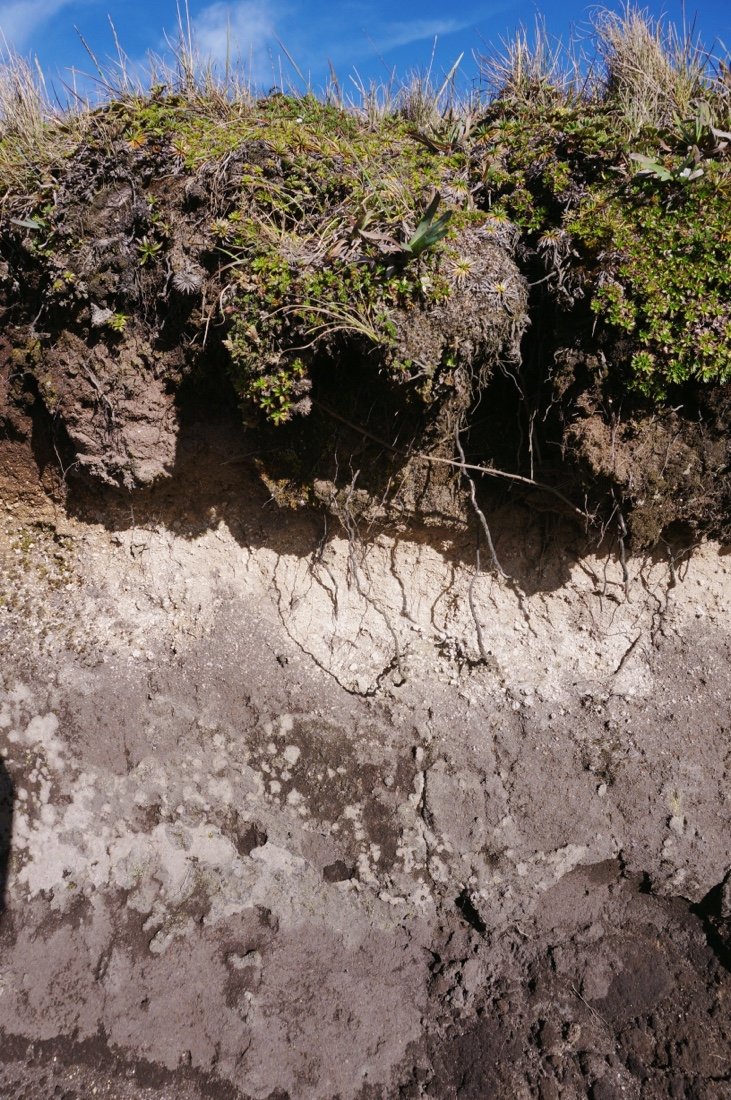 Soil profile... I still love seeing the different soil horizons.
Soil profile... I still love seeing the different soil horizons.  ...back in the grass tussocks of the Paramo
...back in the grass tussocks of the Paramo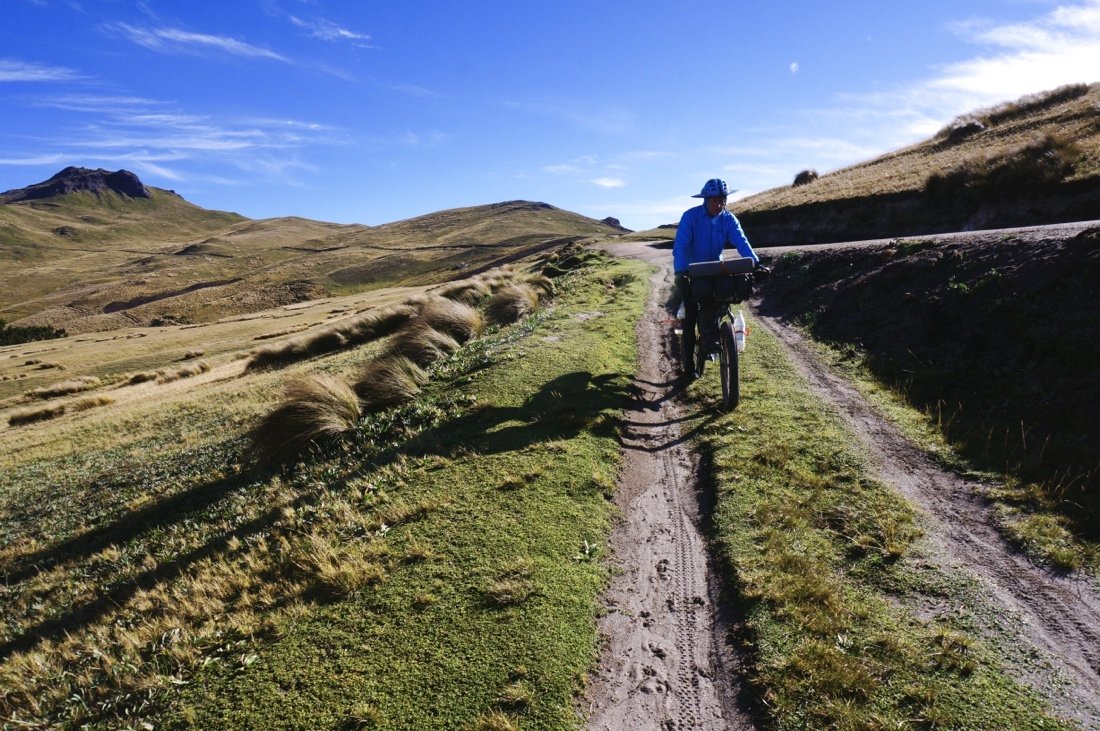

 Alpaca mama and baby...
Alpaca mama and baby...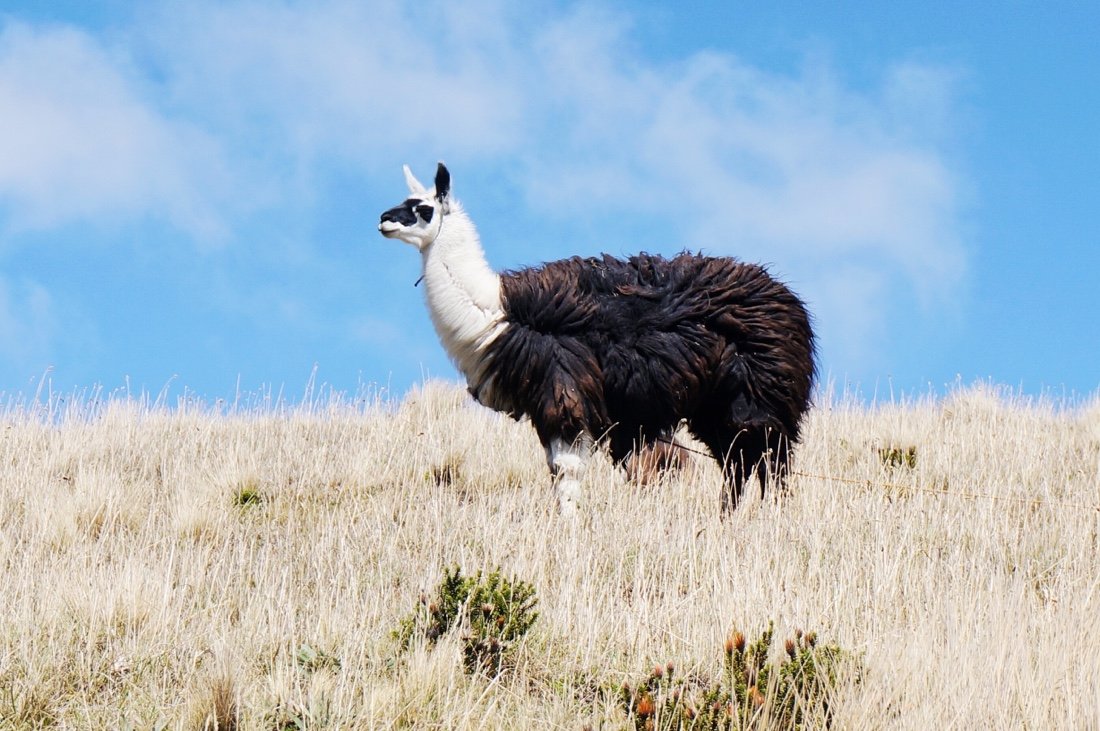
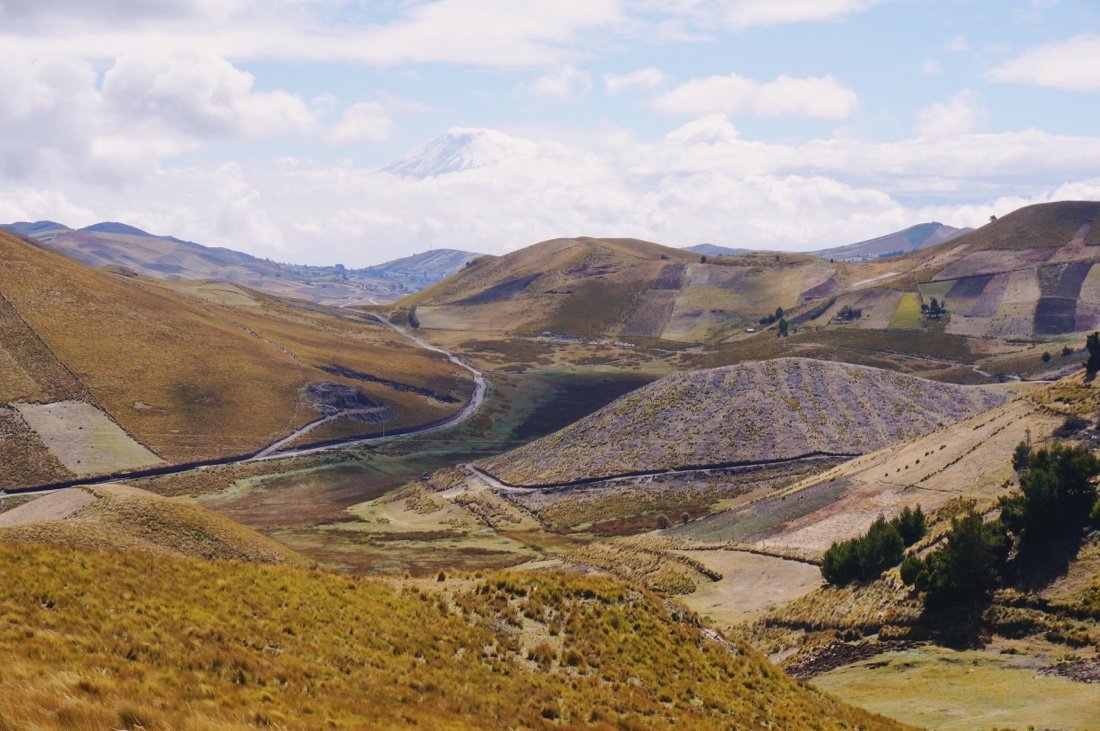 ...more patchwork-quilt farmland
...more patchwork-quilt farmland
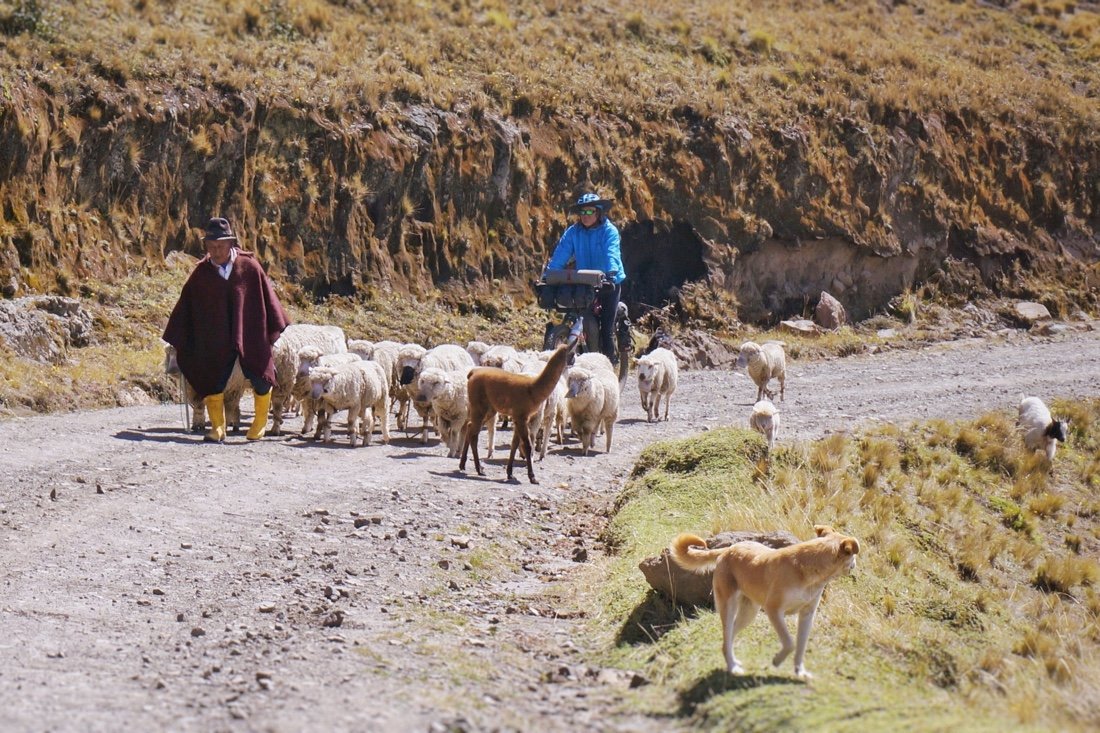 Neon making his way through a shepherd and his herd, llama, and dog...
Neon making his way through a shepherd and his herd, llama, and dog... After winding our way through the grassy paramo and patchwork-quilt farmland we descended down into the Toachi River valley, passing small villages and more farmland along the way.
After winding our way through the grassy paramo and patchwork-quilt farmland we descended down into the Toachi River valley, passing small villages and more farmland along the way. Chochos, as the beans from these Lupine plants are called locally. I'm not sure if the plant is also called "chocho" here, but it is a species of Lupine that is a common food plant in the Andes. I believe there is another Lupine species that is cultivated for the beans in Italy as well. And as a side note for those that don't know--don't just go eating lupine beans, as most are extremely poisonous, and even these take special preparations of soaking and draining, but prepared properly, they are delicious!
Chochos, as the beans from these Lupine plants are called locally. I'm not sure if the plant is also called "chocho" here, but it is a species of Lupine that is a common food plant in the Andes. I believe there is another Lupine species that is cultivated for the beans in Italy as well. And as a side note for those that don't know--don't just go eating lupine beans, as most are extremely poisonous, and even these take special preparations of soaking and draining, but prepared properly, they are delicious! Neon pointing the way down the steep rutted trail where our route leads...
Neon pointing the way down the steep rutted trail where our route leads...

 I believe this part of the route was the steepest hike-a-bike descent I've ever done. The footing was very loose, and it was quite steep. You can see the lower part of the descent (in the photo below) where the trail is bordered by bushy grass zig-zagging down the hill slope.
I believe this part of the route was the steepest hike-a-bike descent I've ever done. The footing was very loose, and it was quite steep. You can see the lower part of the descent (in the photo below) where the trail is bordered by bushy grass zig-zagging down the hill slope.
 At the bottom of the valley, across the Toachi River we passed through another small village. Many of the buildings had been damaged by an earthquake and looked like they were no longer in use.
At the bottom of the valley, across the Toachi River we passed through another small village. Many of the buildings had been damaged by an earthquake and looked like they were no longer in use. ...more chochos
...more chochos
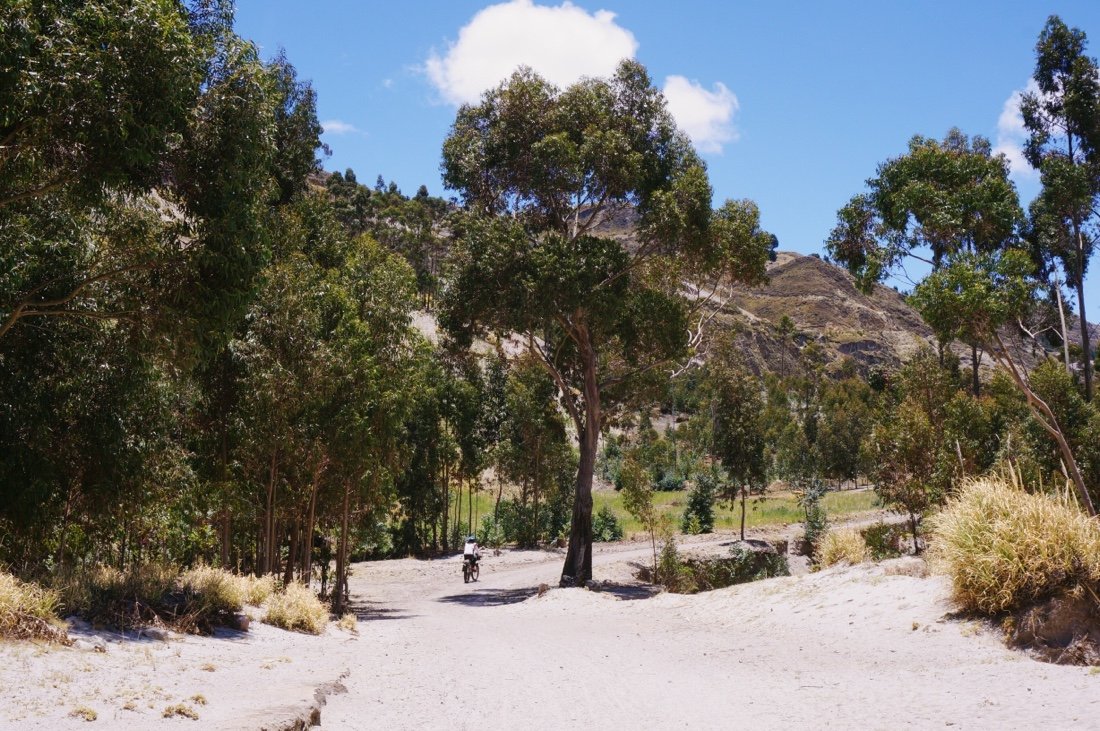 We climbed out of the river valley on a well graded dirt road. It was hot, and more desert-like than anywhere we had ridden in a long time. We saw a number of cactus and yucca-like plants.
We climbed out of the river valley on a well graded dirt road. It was hot, and more desert-like than anywhere we had ridden in a long time. We saw a number of cactus and yucca-like plants.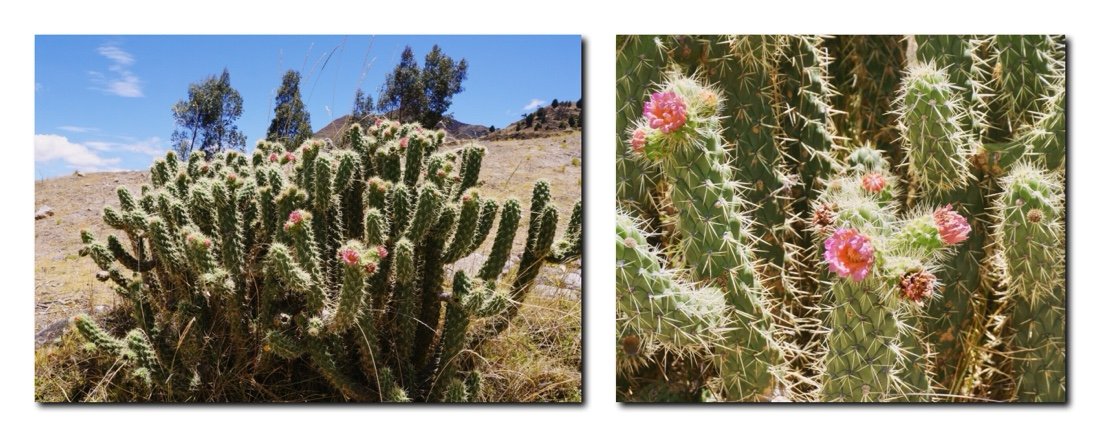
 Chochos, glowing in the afternoon light...
Chochos, glowing in the afternoon light...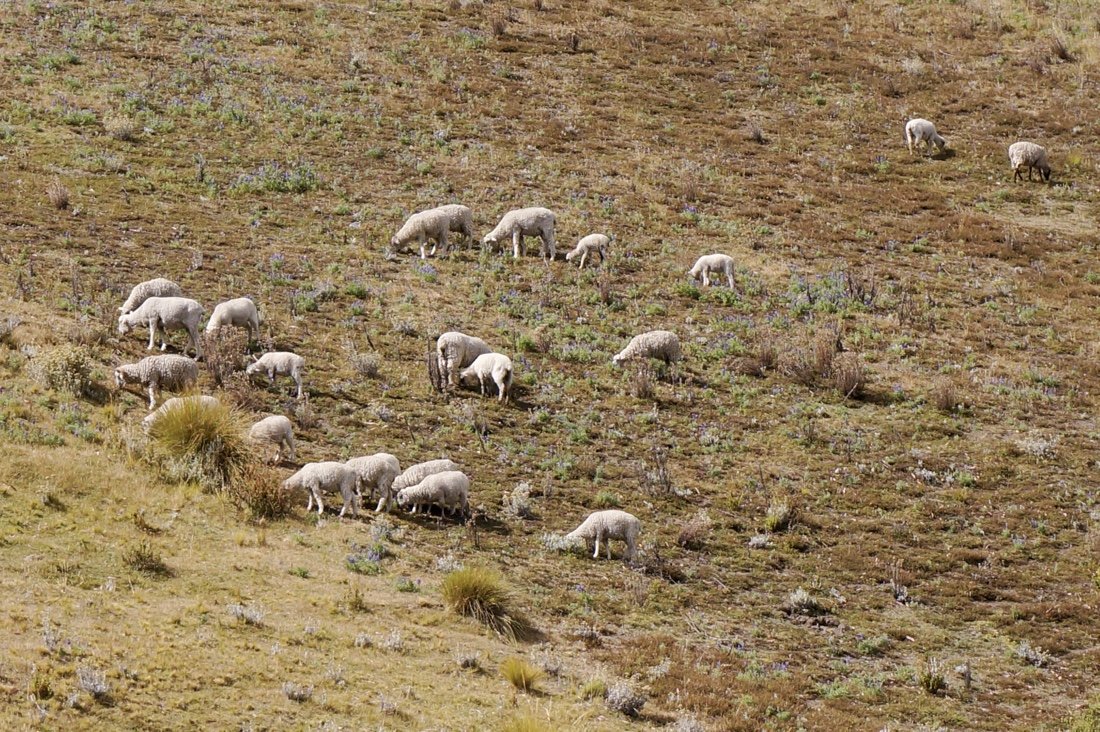 Sheep, grazing on the nearly barren hillside...
Sheep, grazing on the nearly barren hillside... We detoured around the first part of the steep hike-a-bike, continuing on the dirt road until we reached Shalala, a tourist lodge and trails, near the crater ridge of Quilatoa.
We detoured around the first part of the steep hike-a-bike, continuing on the dirt road until we reached Shalala, a tourist lodge and trails, near the crater ridge of Quilatoa. We gained the crater rim on steep trails before reaching a road that led into the small town of Quilatoa, where we found a reasonably priced room in a hostal for the night.
We gained the crater rim on steep trails before reaching a road that led into the small town of Quilatoa, where we found a reasonably priced room in a hostal for the night.
 The next morning a fast descent on pavement led us to Zumbahua. We stopped in several of the little stores to resupply, found espresso in one of the small cafes, and got some food to go from one of the food carts in the square.
The next morning a fast descent on pavement led us to Zumbahua. We stopped in several of the little stores to resupply, found espresso in one of the small cafes, and got some food to go from one of the food carts in the square.
 Another coffee photo, because espresso, and I loved the tiny china cups...
Another coffee photo, because espresso, and I loved the tiny china cups...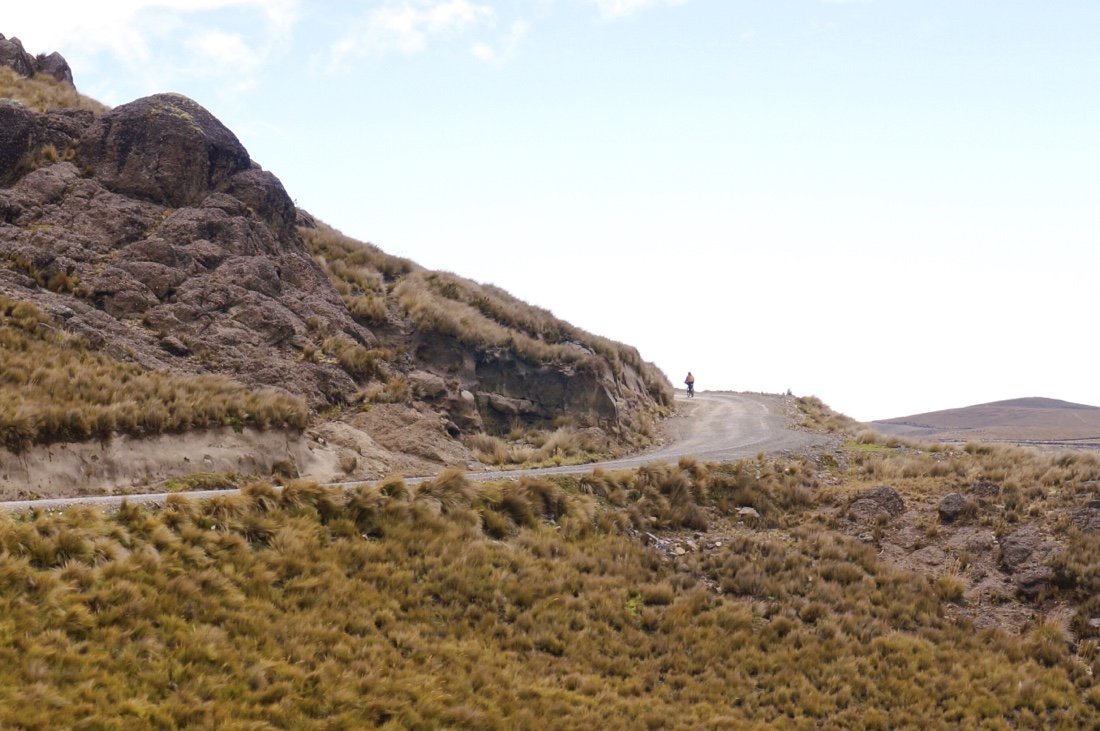 After Zumbahua we climbed back into the paramo.
After Zumbahua we climbed back into the paramo.



 At the top of a pass we detoured down a smaller dirt road to look for camping. We found a flat spot, perched above the road, with views of the valleys on either side.
At the top of a pass we detoured down a smaller dirt road to look for camping. We found a flat spot, perched above the road, with views of the valleys on either side.


 I stared out the tent door, tucked in and cozy, as the sun grew heavy on the horizon. The air was crisp, but still. A silence rose as the sun dipped below the horizon. Fluffy clouds filled the sky, turning orange and pink with the setting sun. The wind blew gently, against the rolled up door of the tent, as I drifted off to sleep. All was calm ...until I woke in the night to the slapping sound of the wind against the tent. Fwap, fwap, fwap—the tent danced around wildly. I woke several times to push back against the tent to keep it from smacking my head.By morning there were sustained winds of 50 mph, with gusts of 70 and 80 mph. There was no coffee, no pooping—only panic to pack up as quickly as we could, without loosing anything to the fury of the wind.[Have you ever climbed Mount Washington in New Hampshire in the winter? If you have then you know the kind of wind I’m talking about. It’s the kind of wind that when it pushes you over, it’s almost impossible to get back up.]
I stared out the tent door, tucked in and cozy, as the sun grew heavy on the horizon. The air was crisp, but still. A silence rose as the sun dipped below the horizon. Fluffy clouds filled the sky, turning orange and pink with the setting sun. The wind blew gently, against the rolled up door of the tent, as I drifted off to sleep. All was calm ...until I woke in the night to the slapping sound of the wind against the tent. Fwap, fwap, fwap—the tent danced around wildly. I woke several times to push back against the tent to keep it from smacking my head.By morning there were sustained winds of 50 mph, with gusts of 70 and 80 mph. There was no coffee, no pooping—only panic to pack up as quickly as we could, without loosing anything to the fury of the wind.[Have you ever climbed Mount Washington in New Hampshire in the winter? If you have then you know the kind of wind I’m talking about. It’s the kind of wind that when it pushes you over, it’s almost impossible to get back up.] Baby pigs, you can tell how small they are by the size of the puppy in the photo...•It was windy all day and our spirits began to wane with every push of the wind. We stopped for second breakfast in Angamarca. The lady at a little tienda knocked on the wooden window across the street to ask about breakfast for us. A women poked her head out the window to look at us, she squinted and closed the window. A moment later she opened the front doors on the corner and waved at us to come inside.She brought us hot water for coffee, and began dishing up two plates of food before even telling us what she had. I looked at Neon and said "It looks like chicken; do you want my chicken?" She sat two plates down in front of us--full of rice, lettuce, chicken, and a banana each. I was really happy about the banana. I put my chicken on Neon's plate and happily peeled my banana, then ate a little of the rice with my lettuce. I had food on my bike, but with so much effort exerted to get through the wind, I was happy to have some extra calories to get me through, especially since we were still so far from the next, better stocked, town.
Baby pigs, you can tell how small they are by the size of the puppy in the photo...•It was windy all day and our spirits began to wane with every push of the wind. We stopped for second breakfast in Angamarca. The lady at a little tienda knocked on the wooden window across the street to ask about breakfast for us. A women poked her head out the window to look at us, she squinted and closed the window. A moment later she opened the front doors on the corner and waved at us to come inside.She brought us hot water for coffee, and began dishing up two plates of food before even telling us what she had. I looked at Neon and said "It looks like chicken; do you want my chicken?" She sat two plates down in front of us--full of rice, lettuce, chicken, and a banana each. I was really happy about the banana. I put my chicken on Neon's plate and happily peeled my banana, then ate a little of the rice with my lettuce. I had food on my bike, but with so much effort exerted to get through the wind, I was happy to have some extra calories to get me through, especially since we were still so far from the next, better stocked, town.

 Looking back on Angamarca and the other small villages below it...
Looking back on Angamarca and the other small villages below it... The wind continued through the morning and into the afternoon. We were pretty exhausted by this point, and took a short break every time we encountered a sheltered nook in the landscape.
The wind continued through the morning and into the afternoon. We were pretty exhausted by this point, and took a short break every time we encountered a sheltered nook in the landscape.
 We grew a bit desperate by the evening hours, wondering where we might find a sheltered place to camp. We finally found a place nestled in some trees. It was still extremely windy, and even with the trees blocking a lot of wind, the wind was so strong, I had to tie the corners of the tent to our bikes and to the surrounding trees, because the wind kept pulling the stakes out of ground.
We grew a bit desperate by the evening hours, wondering where we might find a sheltered place to camp. We finally found a place nestled in some trees. It was still extremely windy, and even with the trees blocking a lot of wind, the wind was so strong, I had to tie the corners of the tent to our bikes and to the surrounding trees, because the wind kept pulling the stakes out of ground.


 I'm usually completely happy to forge my way through whatever difficulties present themselves, but by the time we were approaching Simiatug, not even midday yet, I turned to Neon, and said "when we get to Simiatug we either need to hire a truck to Salinas or get a room for the night because I'm done, at least for today".
I'm usually completely happy to forge my way through whatever difficulties present themselves, but by the time we were approaching Simiatug, not even midday yet, I turned to Neon, and said "when we get to Simiatug we either need to hire a truck to Salinas or get a room for the night because I'm done, at least for today". With two solid days of wind, big wind, the kind of wind that pushes you over, the struggle had become so exhausting—being pushed over, dropping the bike, sliding backwards [uphill] while riding downhill, and nearly being swept off cliff side—when we got to Simiatug, we hired a collectivo pickup (taxi) to take us to Salinas. The collectivo took the same route (mostly) that we would have ridden on the bikes. It was beautiful terrain with interesting rock features, and our first view of Chimborazo, but I was so happy to be all done battling the wind.
With two solid days of wind, big wind, the kind of wind that pushes you over, the struggle had become so exhausting—being pushed over, dropping the bike, sliding backwards [uphill] while riding downhill, and nearly being swept off cliff side—when we got to Simiatug, we hired a collectivo pickup (taxi) to take us to Salinas. The collectivo took the same route (mostly) that we would have ridden on the bikes. It was beautiful terrain with interesting rock features, and our first view of Chimborazo, but I was so happy to be all done battling the wind. The central square in Salinas--there were always people gathered round, and kids playing volley ball.
The central square in Salinas--there were always people gathered round, and kids playing volley ball. We were so exhausted from all that wind, we decided to take a day off in Salinas. It was a cute town with great pizza, good coffee, and a chocolate factory. I would have liked to have toured the chocolate factory, but after taking a taxi to the bigger town of Guaranda to get cash, we decided to skip the tour and just spend some time recuperating. I did however purchase some of the best dark chocolate I'd had since finding a Lindt dark chocolate bar in Baja California.••_____________________You can sign up to receive The Redheaded Nomad’s blog posts in your email inbox; sign up at the bottom of any page on my website: theredheadednomad.com•For more frequent updates, follow me on Instagram at: instagram.com/theredheadednomad•You can also find me on facebook at: facebook.com/redheadednomad•If you enjoy my posts and would like to make a contribution toward my travel expenses, or just buy me a coffee in appreciation, you can send an amount of your choosing through my paypal.me address:paypal.me/inthewildland_____________________
We were so exhausted from all that wind, we decided to take a day off in Salinas. It was a cute town with great pizza, good coffee, and a chocolate factory. I would have liked to have toured the chocolate factory, but after taking a taxi to the bigger town of Guaranda to get cash, we decided to skip the tour and just spend some time recuperating. I did however purchase some of the best dark chocolate I'd had since finding a Lindt dark chocolate bar in Baja California.••_____________________You can sign up to receive The Redheaded Nomad’s blog posts in your email inbox; sign up at the bottom of any page on my website: theredheadednomad.com•For more frequent updates, follow me on Instagram at: instagram.com/theredheadednomad•You can also find me on facebook at: facebook.com/redheadednomad•If you enjoy my posts and would like to make a contribution toward my travel expenses, or just buy me a coffee in appreciation, you can send an amount of your choosing through my paypal.me address:paypal.me/inthewildland_____________________
